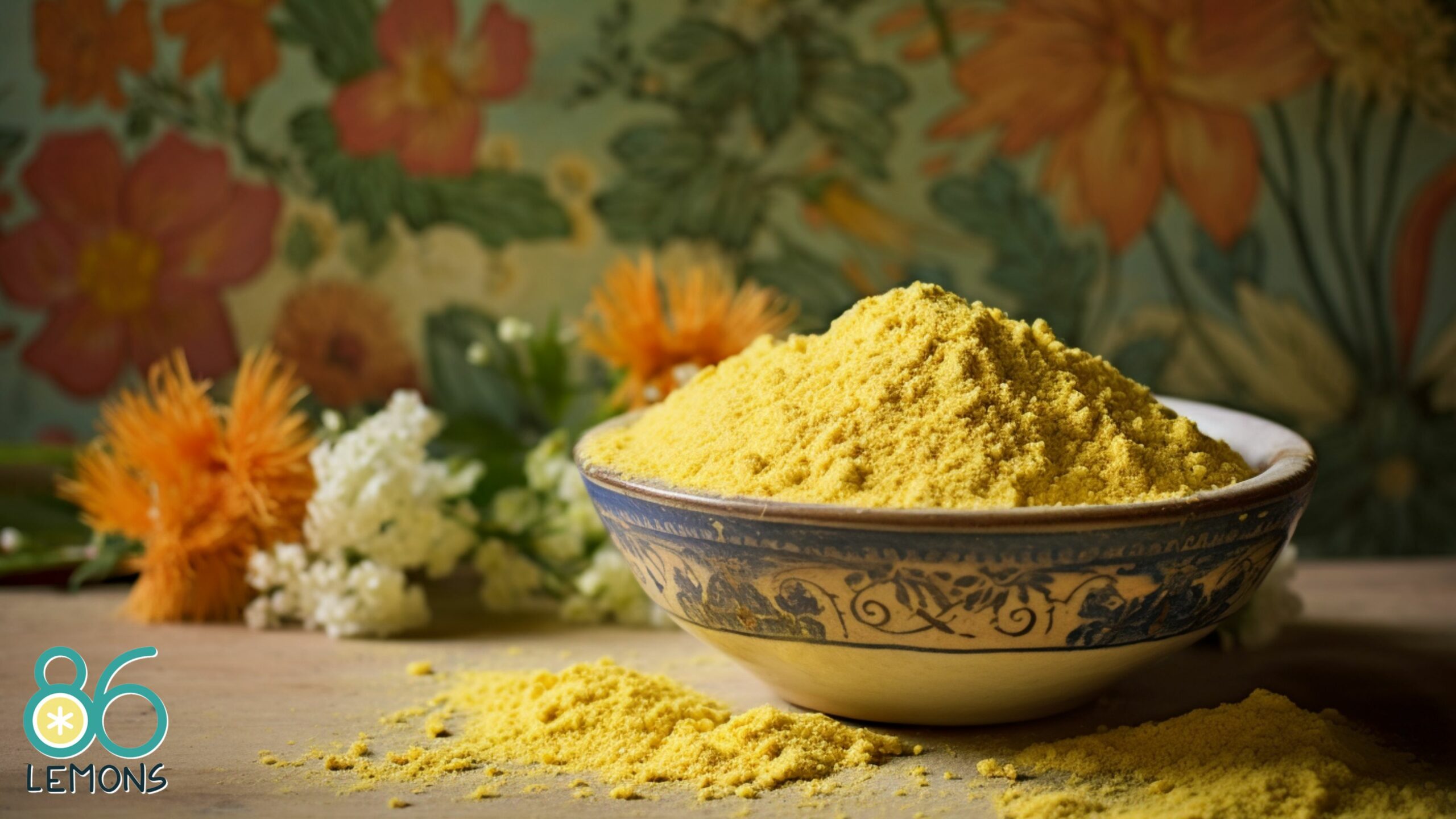Embark on a culinary journey as we dive into the fascinating realm of nutritional yeast – a versatile ingredient known for its nutty, cheesy goodness. Join me in exploring its origins, nutritional benefits, and why it’s a staple in vegan kitchens.
But what if you need an alternative? Fear not! Discover myriad nutritional yeast substitutes, from miso paste to mushrooms, opening up a world of creative cooking possibilities.
Whether you’re a seasoned chef or a kitchen novice, let’s unravel the secrets of nutritional yeast. Ready your best vegan cookbooks and transform your recipes with these innovative and flavorful substitutes.
Understanding Nutritional Yeast

As someone who loves exploring different ingredients, I’ve come across nutritional yeast often. So, let me give you a brief idea of what it is. Nutritional yeast comes from a yeast species called Saccharomyces cerevisiae, the same species used in bread and beer production.
But unlike yeast for bread, nutritional yeast is made through a fermentation process that kills the yeast cells, making it inactive. The result is a flakey, yellow powder packed with nutrients like protein, vitamins, and minerals. Nutritional yeast is an excellent source of B vitamins, which are crucial for vegans as they’re often lacking in plant-based diets.
One of the many things I appreciate about nutritional yeast is its versatility in vegan cooking. Thanks to its unique nutty and cheesy flavor, it’s a popular choice for enhancing various dishes such as:
- Pastas and sauces
- Sprinkling on popcorn
- Adding to soups and stews
Besides being a delicious flavor booster, nutritional yeast is also a reliable source of protein. It contains essential amino acids our bodies need but can’t produce independently.
In conclusion, nutritional yeast is a must-have ingredient for anyone interested in adding depth to their dishes while ensuring they get those essential nutrients.
Why Seek Substitutes?
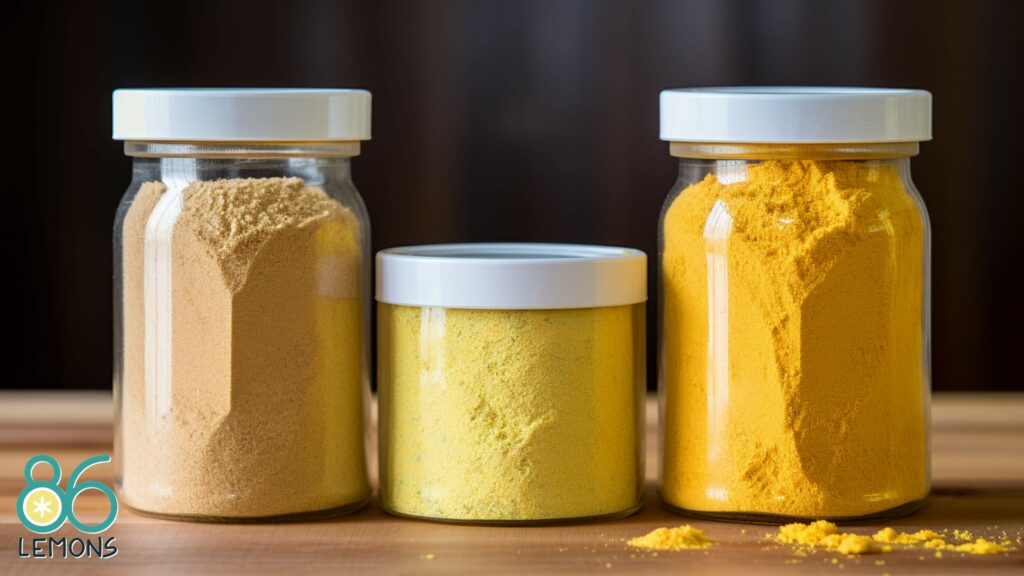
You might wonder why someone would want to look for nutritional yeast substitutes when it’s such a popular ingredient in vegan and vegetarian cooking. Well, I’ve found a few compelling reasons worth discussing, such as allergies, dietary preferences, and availability.
Firstly, some people have allergies or sensitivities to yeast, making it necessary for them to find suitable alternatives. On top of that, specific diets like yeast-free or Paleo may require the exclusion of this popular ingredient, making it essential to explore other options.
Replacing nutritional yeast with an alternative that aligns with one’s dietary preferences can help maintain the savory flavors one is used to while accommodating one’s needs. Moreover, nutritional yeast isn’t always easy to find for everyone, depending on where they live or shop.
Sometimes, it might simply be unavailable or too expensive, so knowing there are other options is excellent. Using suitable substitutes, I can still create delicious recipes without jeopardizing my budget or driving hundreds of miles to find a store that sells them.
Another factor to consider is the diverse health benefits of using different ingredients. For instance, garlic is immune-boosting, while sunflower seeds contain vitamins and minerals. Sometimes, switching up components provides unique advantages that might be absent from using nutritional yeast alone.
In summary, seeking nutritional yeast substitutes makes sense due to allergies, dietary preferences, availability, and health benefits. Don’t worry about compromising the taste or quality of your dishes! With these suitable alternatives, you can confidently create your favorite vegan or vegetarian meals, knowing there’s something out there for every plate and occasion.
Natural Flavor Enhancers
Miso Paste and Miso Varieties
I’ve found that miso paste is a fantastic substitute for nutritional yeast in many vegan recipes. Miso paste is made from fermented soybeans, which gives it a delicious umami flavor. It can add depth and saltiness to your dishes, similar to what you would get with nutritional yeast.
The most common type of miso paste to use in place of nutritional yeast is white miso paste, which has a milder taste than other miso varieties. However, other types of miso paste can also provide that desired umami kick. Some of the miso paste varieties include:
- Yellow miso for a subtle, earthy flavor
- Red miso for a stronger, saltier taste
- Barley miso for a more robust, hearty addition
Feel free to experiment with these miso pastes to find the perfect flavor enhancer for your recipes!
Soy Sauce and Liquid Aminos
Another great way to enhance the umami flavor in your dishes is by using soy sauce or liquid aminos. Soy sauce is a popular condiment in many cuisines, especially Asian dishes, and it’s perfect for adding that salty, umami flavor we’re always looking for.
- When using soy sauce, be mindful of its high salt content, so adjust your recipe’s added salt accordingly. I recommend trying lower sodium versions to keep the saltiness in check.
- Alternatively, liquid aminos are an excellent choice, especially if you follow a gluten-free diet. Made from soy protein and water, liquid aminos taste similar to soy sauce but without the wheat.
- Coconut aminos are another option derived from the sap of a coconut tree. They taste slightly sweeter than soy sauce but still deliver that umami punch.
- Tamari, a Japanese soy sauce, offers a thicker consistency and a slightly less salty flavor for those seeking a subtle option.
Adding these umami powerhouses to your cuisine will help elevate your recipes and satisfy your nutritional yeast substitution needs!
Nut and Seed Options
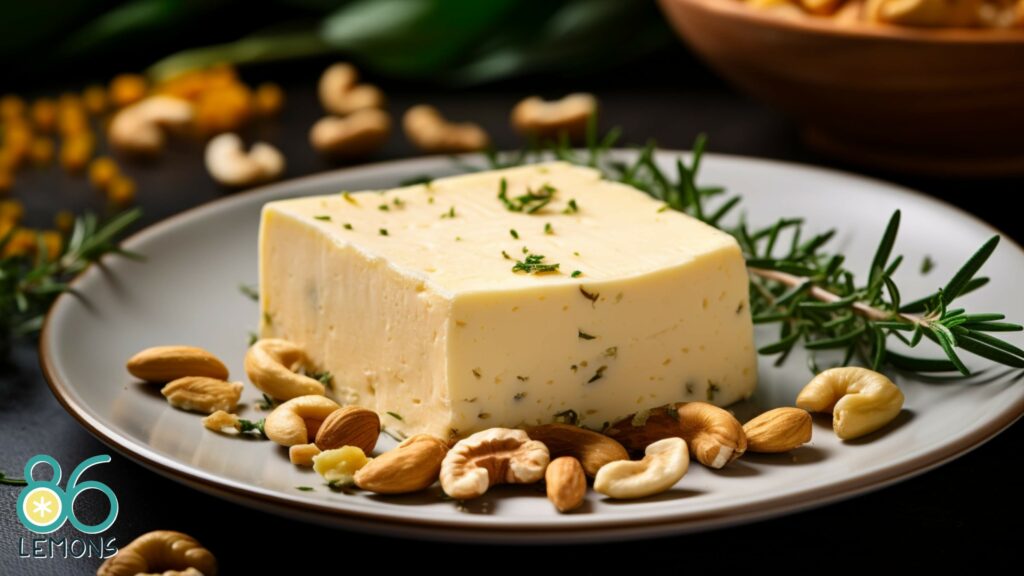
Cashews and Vegan Cheese
In my experience, nuts and seeds offer excellent alternatives for replicating nutritional yeast’s nutty flavor and texture. One of my favorite options is cashews. When ground, cashews can easily imitate the cheesy flavor we often crave, making them an ideal option for various dishes.
To create, grind cashews in a food processor until they reach a fine consistency. This can be used directly as a topping instead of nutritional yeast for a pleasant nutty flavor. In addition, ground cashews are known as the base for many vegan cheese recipes, such as vegan cream cheese.
Vegan parmesan cheese is another perfect example. Made with simple ingredients like ground cashews, garlic powder, and salt, it can easily trick your taste buds into thinking you’re enjoying the real thing. You’ll love its texture and cheesy flavor, which perfectly matches pasta dishes or salads.
You can create a vegan cheese sauce using soaked cashews for a creamier alternative. By blending them with garlic powder, lemon juice, water, and a pinch of salt, you’ll achieve a smooth sauce that can be poured over veggies, pasta, or even nachos for an extra indulgence.
One important note: cashews are naturally high in fat, a critical factor in achieving that rich and creamy texture. So, while they may not offer the same low-fat benefits as nutritional yeast, they provide an excellent vegan-friendly option to satisfy cheesy cravings.
So whether it’s topping off your favorite dishes or creating vegan cheese from scratch, incorporating nuts and seeds like cashews into your culinary routine is a delicious and versatile way to keep things interesting and enjoyable!
Yeast Extract Variants
Brewer’s Yeast and Marmite
When I think of nutritional yeast substitutes, yeast extract variants readily come to mind. Among them are brewer’s yeast and Marmite. Both can serve as excellent alternatives, albeit with slight differences in flavors and nutritional profiles.
Brewer’s yeast, derived from the Saccharomyces cerevisiae species, is similar to nutritional yeast. They share a common origin, as both are byproducts of the beer brewing process.
However, their taste and consistency differ. While nutritional yeast brings a cheesy, nutty flavor, brewer’s yeast tastes more bitter. It works well in some savory dishes and provides many proteins, B12, and amino acids.
Another yeast extract variant that caught my attention is Marmite, a famous British spread made from yeast extract. Although its taste can be polarizing — many describe it as a concentrated, salty, and savory flavor — it’s packed with B vitamins.
It could be a unique nutritional yeast substitute in specific recipes. It’s worth noting that if you prefer a milder alternative to Marmite, you can opt for Vegemite, its Australian cousin.
| Yeast Extract Variant | Flavor | Nutritional Profile |
|---|---|---|
| Brewer’s Yeast | Bitter, savory | Proteins, B12, amino acids |
| Marmite | Concentrated, salty | B vitamins |
| Vegemite | Milder than Marmite | B vitamins |
In conclusion, brewer’s yeast and Marmite can serve as adequate nutritional yeast substitutes, depending on the desired flavor and nutritional content. Remember that it may take some experimenting to determine which yeast extract variants best suit your needs and taste preferences. Happy cooking!
Utilizing Mushrooms and Fungi
As a cooking enthusiast, I’ve discovered that mushrooms can be a great substitute for nutritional yeast in various recipes. They bring out that delicious umami flavor, particularly in soups and roasted veggies, and can significantly affect the taste.
Dried Mushrooms and Powder
One of the best alternatives to nutritional yeast I’ve encountered is using dried mushrooms, especially porcini, shiitake, and chanterelle. These types of mushrooms, when dried, have a concentrated taste that adds depth to dishes.
To get the most out of them, I grind the dried mushrooms into a fine powder that can be easily incorporated into recipes. Some benefits I’ve noticed while using mushroom powder include:
- Umami flavor: Mushroom powder brings an earthy, savory element to dishes that might otherwise miss out on the rich taste nutritional yeast offers.
- Versatility: You can sprinkle the mushroom powder into soups, sauces, or roasted veggies for an instant burst of umami.
- Convenience: Mushroom powder can be stored longer than fresh mushrooms and is lighter to carry if needed.
In my experience, combining mushrooms with other ingredients can provide a flavor similar to nutritional yeast. For example, a mixture of mushroom powder, garlic powder, and onion powder might work wonders in replicating the iconic cheesy taste of nutritional yeast. Give it a try and see how it works for your recipes!
Additional Plant-Based Substitutes
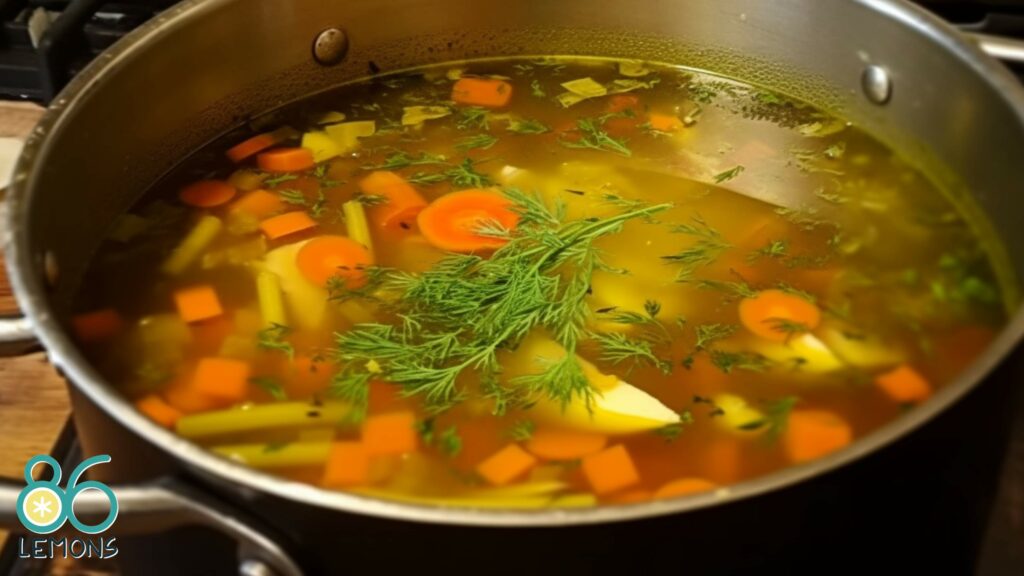
Chickpea Flour and Nutritional Blends
I’ve discovered that chickpea flour is an excellent vegan and gluten-free option for substituting nutritional yeast. Though milder in all aspects, it has a similar texture, flavor, and nutritional value.
For instance, you can easily use chickpea flour in recipes that call for a large amount of nutritional yeast, like ¼ cup or more. Mix it with different spices and herbs that match your dish to amp up the flavor.
Another tremendous vegan alternative I’ve come across is nutritional blends. These might include a mix of spices, herbs, and other plant-based ingredients that work well together to impart a cheesy, savory taste when nutritional yeast isn’t available.
Remember to check the specific blend for its vegan, gluten-free, or dairy-free status, as not all combinations might fall within those categories.
Vegetable Bouillon and Broth
Whenever I’m out of nutritional yeast, I often turn to vegetable bouillon as a handy substitute. It’s available in a cube or powder form, both simple.
Vegetable bouillon provides a savory depth of flavor and is often vegan and vegetarian-friendly. However, remember that not all vegetable bouillon cubes or powders are gluten-free, so you may need to read the labels to monitor gluten intake.
In addition to bouillon, vegetable broth can make a decent substitute for nutritional yeast in specific recipes. Like bouillon, vegetable broths can be store-bought or made at home by simmering various vegetables, spices, and herbs in water.
A homemade broth allows you to adjust the flavors, making it vegan and gluten-free as needed! Try it on this vegan pasta and bean soup for yourself.
So, next time you run out of nutritional yeast, don’t fret. Plenty of plant-based substitutes can help you maintain a vegan, gluten-free, or vegetarian diet while still enjoying delicious, savory flavors in your dishes.
DIY Substitutes
Homemade Nutritional Mixes
Chickpea Flour Mixture: I’ve found that chickpea flour is a fantastic ingredient for creating a homemade nutritional mix. It’s gluten-free, protein-packed, and quickly found at most grocery stores.
Mix a cheese substitute with chickpea flour, water, and your favorite spices to create a thick paste. This mixture can be used in various vegan recipes, such as stews, soups, and salads.
Baking Nutritional Mix: Another option for a homemade nutritional substitute is to create a mixture by combining:
- 1/4 cup of chickpea miso
- A small handful of cashews or macadamia nuts
- A sprinkle of your favorite spices, such as paprika, oregano, and basil
Spread this mixture onto a baking sheet and bake it in the oven until dry and crumbly. Once it’s cooled, you can crumble it up and use it as a cheese substitute in your favorite vegan baking cookbook dishes.
Tip: Store your homemade nutritional mix in an airtight container to ensure freshness.
Cooking Nutritional Mix: When it comes to cooking, I like to make a simple yet delicious cheese substitute by blending:
- 1/2 cup of soaked cashews
- 3 tablespoons of nutritional yeast
- 2 tablespoons of lemon juice
- 1/2 teaspoon of salt
- 1/4 cup of water
This versatile sauce can replace cheese in various vegan dishes, such as pasta or dipping sauce!
So there you have a few ideas for creating homemade nutritional yeast substitutes perfect for vegan recipes. With creativity and simple ingredients, you can easily whip up your healthy mixes in your kitchen.
Creative Cooking Ideas
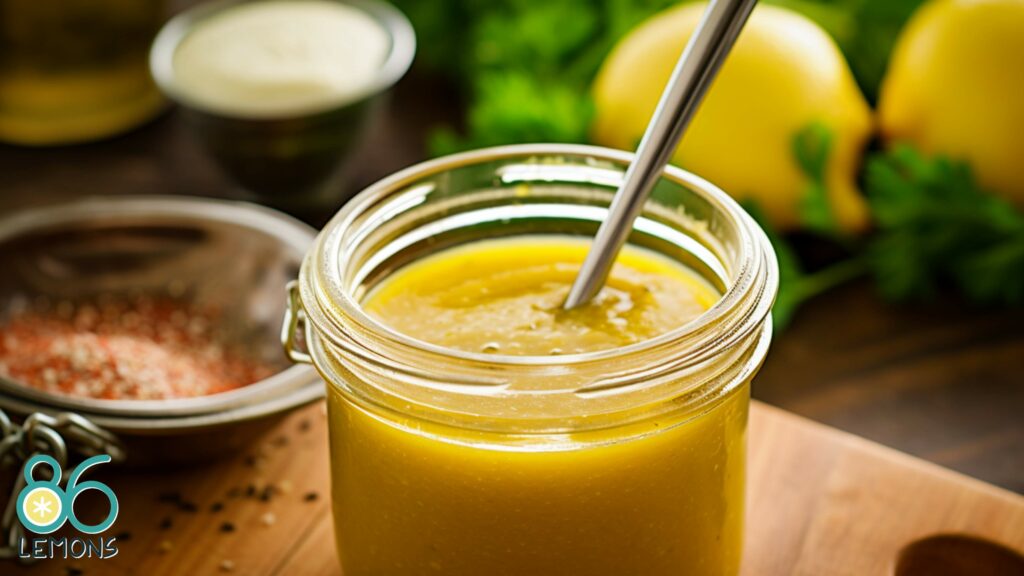
As a cooking enthusiast, I enjoy exploring new substitutes and incorporating them into my recipes. Nutritional yeast is a popular ingredient, especially in vegan cooking, for its cheese-like flavor and added nutrients. If you’re looking for alternatives or want to mix things up, here are some creative cooking ideas using nutritional yeast substitutes.
Sauces and Dressings
One of the most common culinary uses for nutritional yeast is sauces and salad dressings. To keep a creamy texture and cheese flavor, use white miso paste or chickpea flour as substitutes. Here’s a simple vegan sauce to use with pasta or over vegetables:
- 1/4 cup white miso paste or chickpea flour
- 1 cup unsweetened almond milk
- 1/4 cup nutritional yeast substitute
- 2 cloves garlic, minced
- Salt and pepper to taste
In a small saucepan, combine ingredients and whisk until smooth. Cook over medium heat, stirring frequently, until desired consistency is reached. For extra flavor, you can add spices, like garlic powder or dried herbs.
Toppings and Seasonings
Nutritional yeast substitutes can also be used as coatings or toppings for various dishes. For example, brewer’s yeast or dried onion flakes can serve as a crunchy seasoning on top of popcorn, salads, or rice dishes. Here’s a tasty seasoning blend you can try:
| Ingredient | Quantity |
|---|---|
| Dried onion flakes | 2 tbsp |
| Garlic powder | 1 tbsp |
| Paprika | 1 tbsp |
| Nutritional yeast substitute | 1/4 cup |
Mix all ingredients in a small bowl. Sprinkle this blend over your favorite dishes to enhance their flavor and texture. Feel free to swap out or add spices to create your unique seasoning blend!
Incorporating nutritional yeast substitutes in my recipe development has made my vegan cooking more versatile and exciting. I hope you’ll find these creative cooking ideas helpful, too!

